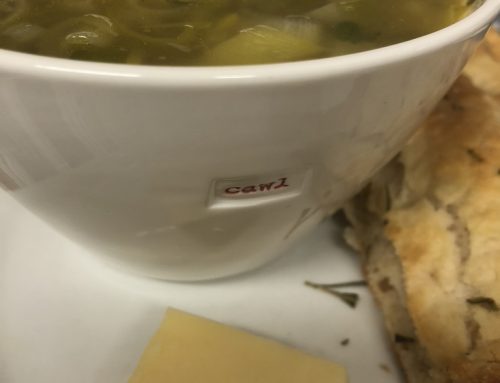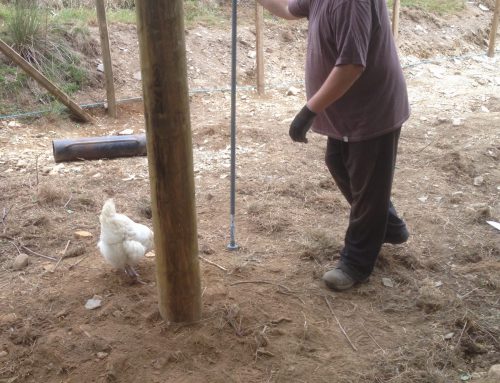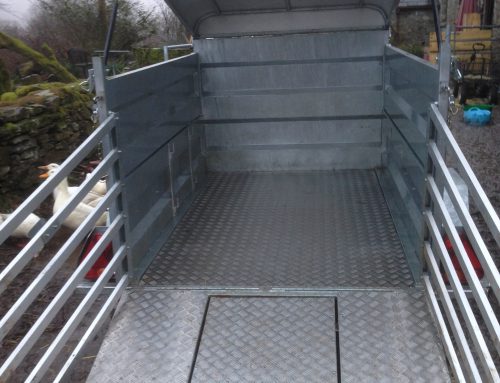Part of our plan for self-sufficiency included breeding and raising a breed of dual purpose chicken the Light Sussex, favourite amongst smallholders for both meat and eggs. As with many plans on our farm, we were still thinking about setting up a chicken run for raising male meat birds separate from laying hens when one of our neighbours was looking to re-home a Light Sussex cockerel and our plans were brought forward. Rocky, a very young cockerel came to live with us at the beginning of July but when introduced to our somewhat mature hybrid hens was given a hard time and the term ‘hen pecked’ was very apt. We decided to slow down the introduction and kept him separate from the girls in a dog crate (with straw, newspaper, sawdust litter, feeder and water drinker) in the workshop. The hens had access to visit him but he was safe behind bars (for his own protection).
We then went on the hunt for a young Light Sussex pullet to be his mate. We bought Bullwinkle (Bo for short), a lovely young lady, and 14 Light Sussex eggs for incubating from a different breeder to Rocky’s origins (these would form our Light Sussex flock). Bullwinkle was set up in a similar dog crate next to Rocky for a week before opening the doors to both crates and allowing them to mingle. Within a few minutes of opening the doors, the pair had mounted each other and established dominance, luckily Rocky came out on top. We kept them together in adjoining crates for a few more days before moving them together into a crate into the hen house. The hens appeared to be indifferent to the newcomers, having got used to visiting them in the workshop and after a few more days we opened the crate door to let Rocky and Bullwinkle out with the other chickens in the morning. To our surprise, Bullwinkle stayed in the crate for a couple more days before getting the courage to come out into the hen house with Rocky and then it took another day to come outside. Now they are fully fledged members of the flock and Rocky is attempting to mount some of the hens despite being half their size. Bullwinkle prefers to sleep in a nesting box with our broody hen, Peggy, rather than roost with the other hens but Rocky roosts in the middle of hens keeping an eye on everyone.



Out of the 14 eggs we brought home with Bullwinkle, only 10 appeared to be fertile at the first candling and then another 2 suffered early mortality (embryo died part way through development). When it came to hatching all 8 remaining eggs hatched successfully. The last chick needed a little assistance as his delayed hatch meant that the internal membranes were starting to dry out and the chick had got stuck to its own eggy feathers. We had learnt a huge amount from hatching ducklings 10 days before and armed with a water spray, damp kitchen towel and tweezers we set about unsticking the chick’s head from under its wing and gently teasing glued feathers apart. The poor little chick had a twisted right foot and one wing it could not extend. We let the chick dry in the incubator and transferred him to the nursery with the others.



The next day we noticed that no. 8’s back end was very mucky, everything was stuck together. We observed the chick for another day but the muck was crusting up. So once again armed with a water spray, damp kitchen towel and tweezers I set about removing all the muck. It took about half an hour and the little chick buried its head in my left arm while I worked on its back end; cheeping when I teasing away stuck debris too hard and quiet when I gently dampened the area. The chick ended up with a bald bum and sadly a little tear in the skin which was dabbed with a wound spray for the next couple of days and has since completely healed. This chick although a little smaller than the others now has two straight feet and both wings flap beautifully.



We have really enjoyed observing the chicks development so far. They do not appear to grow as fast as the ducklings but their instinctive behaviours are more apparent; scratching the flax litter when it was changed from kitchen towel after a few days, trying to roost on cardboard and the heat pad within a week, dust bathing and attempting to fly. The other joy of baby chicks is that they only need cleaning out once a week. Did I mention that ducklings are messy? When we hatched ducklings, they needed cleaning out on a daily (if not twice-daily basis) during their time in the nursery; a dog crate with an old paper feed bag in the bottom tray and flax litter for bedding (awesome stuff), cardboard sides (to reduce draughts) plus a heat pad for warmth, water drinker and food bowl. It would appear that more water ended up in the bottom tray than was in the drinker (at least it felt that way). When I cleaned out the baby chicks today, I lifted out the water drinker, feeder and heat pad, rolled up the old paper feed bag, replaced it with a clean one and sprinkled some flax litter on it and returned the water drinker, feeder and heat pad. It took five minutes and they were ecstatic with the result scratching, rolling and eating the new flax litter. It took them about 20 minutes to calm down.



The other surprise with these baby Light Sussex chicks is the speed at which their feathers are changing from the soft yellow down to a white and black. There is a definite difference between the chicks and it will be interesting to see if this is gender related or just that some were hatched a day or two before the others. Watch this space.







